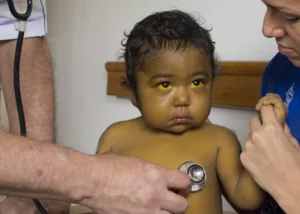An Hepatoblastoma is a malignant tumor that occurs in children under 3 years of age. Up to 50% of liver tumors in general present in children are Hepatoblastoma, as well as an estimated 1,3% of the malignant tumors presented during childhood. Regardless of this rate, it continues to be an uncommon type of cancer, however some reports indicate that Hepatoblastoma cancer cells have increased its occurrence in the last 30 years.
An Hepatoblastoma begins in hepatoblasts, which are precursors of hepatocytes (cells that make up the liver). The reasons for their development are unknown, but in isolated cases it has been associated with different constitutional genetic anomalies, malformations and familiar cancer syndromes, such as: Aicardi Syndrome, Beckwith-Wiedermann Syndrome, Familial Adenomatous Polyposis and Glycogen Storage Disease (Glucogenosis).
Know the symptoms:
The Stanford’s Children Hospital has defined the following symptoms as the most common for this disease: appearance of a growing mass in the abdomen accompanied by a loss of appetite and weight loss, abdominal discomfort, fever, nausea and vomit. Jaundice (yellow coloring of the skin and eyes) could be present in some cases. Other unusual manifestations could be: precocious puberty, osteopenia and low platelet count. Each one of these symptoms may vary according to the size of the tumor, its location and if it has already metastasized to other organs.
How is the diagnostic performed?
A blood test will reveal high levels of alpha phyto protein in 75% of cases and medical imaging such as ultrasound, tomography or nuclear magnetic resonance are key for the diagnostic. A solid Hepatoblastoma marker are the blood levels of the alpha phyto protein, which will be very high, and occasionally the secretion of hCG beta may have increased. Additionally there must be a routine biopsy (made by taking a sample of the affected tissue) to ensure the diagnosis and to be able to classify it according to the subtype of Hepatoblastoma, which will allow to define the therapeutic strategy.
As with every other type of cancer, Hepatoblastoma treatment varies according to the patient. Hepatoblastoma is usually sensible to chemotherapy, but the treatment cornerstone is surgical resection. Surgery, combined with chemotherapy, reaches high remission rates, depending on the presence of factors that may have been identified as bad.
It is worth mentioning that liver transplantation may be an option for the treatment of this disease in those cases where the tumor is non-resectional, which means it may not be removed surgically. The liver transplant has shown to achieve survival rates that currently report to overcome 5 years in 80% of cases.
New and promising research is still being performed in order to understand the genetics, molecular biology and physiopathology of the disease and to be able to perform therapy with greater impact in survival and decreased toxicity.
If you wish to stay updated about this or other liver diseases, their possible treatments and even ways to prevent them, visit our website FundaHigado América or follow our social media accounts @FundaHigado where each day we provide the best information.














